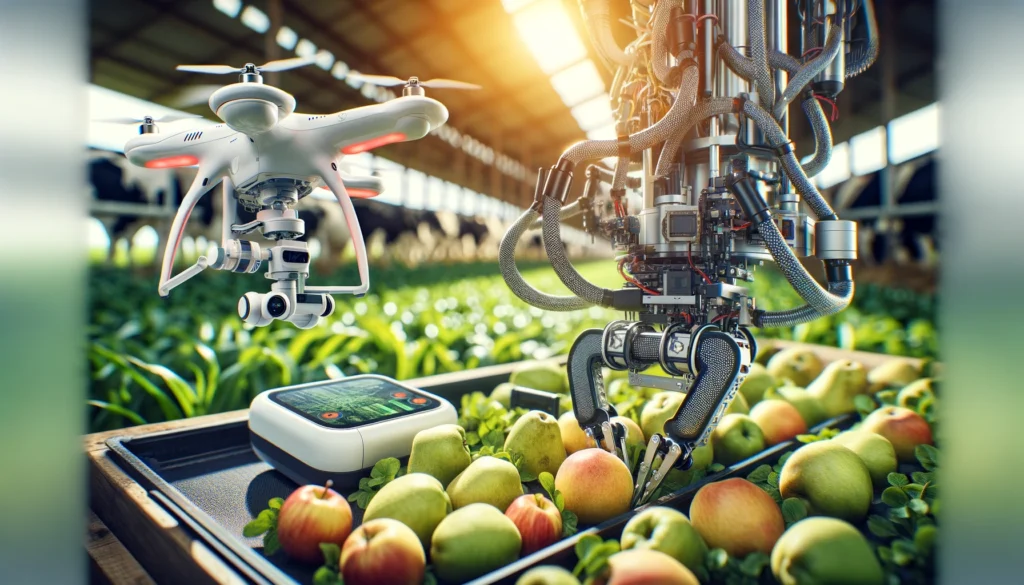
Agriculture Dictionary A close up shot showcasing robotics in agriculture. The focus is on a robotic arm harvesting crops an autonomous drone equipped with sensors and came1.webp.webp
Definition: Robotics in Agriculture
Robotics in agriculture refers to the use of automated machines and robotic technology to perform agricultural tasks. These tasks include planting, weeding, harvesting, monitoring crop health, and managing livestock. Agricultural robots are designed to improve efficiency, reduce labor costs, and increase productivity while ensuring precision and sustainability. Key types of agricultural robots include autonomous tractors, robotic harvesters, drones, and automated milking systems. Robotics in agriculture leverages advancements in artificial intelligence (AI), machine learning, and sensor technology to enhance the overall efficiency and sustainability of farming operations.
Robotics in Agriculture: An In-Depth Guide
Introduction
Robotics is revolutionizing agriculture by providing innovative solutions that enhance the efficiency and sustainability of farming practices. This guide explores the different types of agricultural robots, their benefits, and best practices for implementation and use. Understanding these technologies can help farmers optimize their operations and achieve better outcomes.
Fall off the barn roof and busted your keister? Life on the farm or ranch can be tough on the bum. Need a break? Laugh it off at FarmerCowboy.com, the #1 farm humor site. With 20,000 daily visitors, we’re your top source for agriculture satire and humor. Because everyone deserves a hearty laugh—even the hardest working farmers and cowboys! Join us and turn those long days into fun tales at FarmerCowboy.com.
Types of Agricultural Robots
Agricultural robots can be categorized based on their applications in different farming activities:
1. Autonomous Tractors
Autonomous tractors are self-driving vehicles equipped with GPS and sensors for precise navigation and operation. They can perform tasks such as plowing, planting, and harvesting with minimal human intervention, increasing efficiency and reducing labor costs.
2. Robotic Harvesters
Robotic harvesters are designed to automate the harvesting process for various crops. These machines use advanced sensors and AI to identify ripe produce and pick it with precision, reducing waste and improving crop quality.
3. Drones
Drones, also known as unmanned aerial vehicles (UAVs), are used for aerial surveillance and monitoring of crops. They can capture high-resolution images and data, providing valuable insights into crop health, pest infestations, and field conditions.
4. Automated Milking Systems
Automated milking systems, or milking robots, are used in dairy farming to automate the process of milking cows. These systems improve milk quality, enhance animal welfare, and reduce labor requirements.
5. Weeding Robots
Weeding robots use advanced sensors and AI to identify and remove weeds from fields. These robots can operate with high precision, reducing the need for chemical herbicides and promoting sustainable farming practices.
Key Features of Agricultural Robots
Modern agricultural robots come equipped with various features to enhance their functionality and efficiency:
1. Precision Navigation
Agricultural robots use GPS and advanced sensors to navigate fields with high accuracy. This precision reduces overlap and gaps, optimizing input use and improving efficiency.
2. Automated Task Performance
Robots can perform repetitive tasks such as planting, weeding, and harvesting with consistent accuracy, reducing the need for manual labor and increasing productivity.
3. Real-Time Data Collection
Many agricultural robots are equipped with sensors that collect real-time data on crop health, soil conditions, and field variability. This data helps farmers make informed decisions and improve overall farm management.
4. AI and Machine Learning
Robots use AI and machine learning algorithms to analyze data, identify patterns, and make autonomous decisions. These technologies enable robots to adapt to changing field conditions and optimize their performance.
Benefits of Robotics in Agriculture
Implementing robotics in agriculture offers numerous benefits:
- Increased Efficiency: Robots streamline farming operations, reducing the time and labor required for various tasks.
- Cost Savings: Automation reduces labor costs and optimizes resource use, leading to significant cost savings.
- Enhanced Precision: Agricultural robots perform tasks with high accuracy, leading to better crop yields and improved resource management.
- Improved Sustainability: Robots promote sustainable farming practices by reducing the need for chemical inputs and minimizing environmental impact.
- Better Decision-Making: Data collected by robots helps farmers make informed decisions about field management and resource allocation.
Challenges in Implementing Robotics in Agriculture
Despite their benefits, implementing robotics in agriculture can present several challenges:
- High Initial Costs: Investing in advanced robotic technology requires significant capital, which can be a barrier for small and medium-sized farms.
- Technical Complexity: Operating and maintaining agricultural robots requires specialized knowledge and training.
- Data Management: Managing and interpreting the large amounts of data generated by robots can be challenging.
- Integration Issues: Integrating new robotic systems with existing equipment and practices can be complex and time-consuming.
- Dependence on Infrastructure: Reliable internet connectivity and power supply are essential for the effective use of many agricultural robots.
Best Practices for Implementing Robotics in Agriculture
To maximize the benefits of robotics, consider the following best practices:
1. Conduct a Needs Assessment
Evaluate your farm’s specific needs and challenges to identify the most suitable robotic technologies. Consider factors such as crop type, field size, and resource availability.
2. Invest in Training
Ensure that all operators and farm workers receive proper training on using agricultural robots. This includes understanding how to operate the technology, interpret data, and perform routine maintenance.
3. Start Small
Begin with pilot projects to test new robotic systems on a small scale before full-scale implementation. This allows you to identify potential issues and make necessary adjustments.
4. Prioritize Data Management
Develop a robust data management strategy to ensure data collected from robots is accurate, secure, and accessible. This includes investing in reliable data storage and analytics platforms.
5. Collaborate with Experts
Work with technology providers, agricultural consultants, and research institutions to stay updated on the latest advancements and best practices in agricultural robotics.
Case Study: Successful Implementation of Agricultural Robotics
The Martinez Family Farm
The Martinez family operates a 2,500-acre mixed crop and dairy farm. They successfully integrated various robotic systems into their operations, leading to significant improvements in productivity and sustainability. Key elements of their success included:
- Autonomous Tractors: The Martinez family invested in autonomous tractors, which enhanced planting and harvesting efficiency.
- Robotic Harvesters: Robotic harvesters improved the quality and speed of fruit and vegetable harvesting.
- Drones for Crop Monitoring: Drones provided valuable data on crop health and field conditions, allowing for timely interventions and better management.
- Automated Milking Systems: Milking robots improved milk quality and animal welfare while reducing labor costs.
Results
The Martinez family’s investment in agricultural robotics led to increased crop yields, improved resource efficiency, and enhanced sustainability. The use of advanced robotic technology contributed to cost savings and better overall farm management.
Conclusion
Robotics in agriculture is essential for the efficiency and productivity of modern farming operations. By investing in advanced robotic technology, farmers can enhance their operations and support sustainable farming practices. Understanding the different types of agricultural robots and best practices for their implementation and use is crucial for maximizing the benefits and ensuring the long-term success of a farm.
How Knowledge of Robotics in Agriculture Can Help Farmers
Understanding robotics in agriculture helps farmers make informed decisions about technology investments, maintenance, and upgrades. Knowledge of different types of agricultural robots and their applications enables farmers to optimize resource use, enhance productivity, and ensure the safety and welfare of their workers and livestock. This understanding also supports sustainable farming practices and long-term agricultural success.
Resources for Further Reading
To further explore robotics in agriculture and related topics, visit the following resources:
IMAGES

Originally posted 2024-05-24 09:44:37.
Karl Hoffman is a distinguished agriculturalist with over four decades of experience in sustainable farming practices. He holds a Ph.D. in Agronomy from Cornell University and has made significant contributions as a professor at Iowa State University. Hoffman’s groundbreaking research on integrated pest management and soil health has revolutionized modern agriculture. As a respected farm journalist, his column “Field Notes with Karl Hoffman” and his blog “The Modern Farmer” provide insightful, practical advice to a global audience. Hoffman’s work with the USDA and the United Nations FAO has enhanced food security worldwide. His awards include the USDA’s Distinguished Service Award and the World Food Prize, reflecting his profound impact on agriculture and sustainability.





Asmongold vs. Elon Musk — Self-driving Teslas: the perfect way to game through your daily drive.